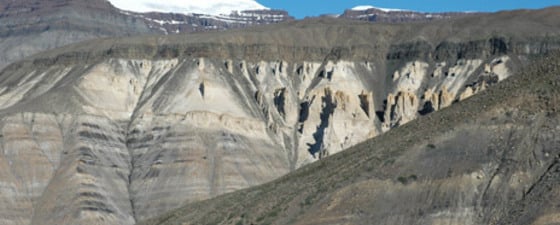“The presence of both oil and gas confirms an active, working petroleum system in the basin and is extremely encouraging at this very early stage of our exploration campaign, for the Sigguk block and the entire area,” says Sir Bill Gammel, CEO of Cairn Energy.
Gammel refers to the current exploration campaign in the Disko West area, 150–200 km offshore West Greenland. The total licensing area in Disko West and Baffin Bay, currently awaiting awards of new licenses, covers more than 200,000 km², equivalent to 29 North Sea Quadrants. The Disko West/Baffin Bay Basin is thus similar in size to the whole North Sea Basin. The 2D seismic and airborne data acquired by TGS Nopec over the last 5 years has revealed numerous structures and a thick sequence of sedimentary rocks.
Following approval from the Greenland Government for four wells, Cairn is implementing a two-rig drilling programme. Operations are being carried out by a drillship and a semi-submersible drilling rig, supported by a range of vessels including six ice management vessels, two emergency response and rescue vessels, two supply boats, with additional vessels for support accommodating crews if necessary.
So far, one well, T8-1, has been completed (TD 3.250m) after finding non-commercial gas in thin sands. Another well, Alpha-1S1, is drilling ahead of schedule, having reached an intermediate depth of 4.358m by 21 September. According to the operator, the well has encountered gas shows in silty and volcanic sections over several hundred metres. Oil has also been observed intermittently over a 400m section in the Paleocene volcanic and volcanoclastic intervals. The third well, T4-1, was drilling as of September 21 with no further news about shows.
Few wells to date
It is believed that the oil will be found in volcanoclastic rocks of Tertiary origin, as it is onshore, and as the well goes deeper, it may enter sandstones of Palaeocene-Cretaceous age, also similar to those observed onshore.
Over the past 20 years Cairn has had a focus on South Asia. This has resulted in over 40 oil and gas discoveries and the development of major fields in both India and Bangladesh. In 2006, the company had an early entry and secured a strategic frontier exploration position in Greenland and it is the only company in recent years to drill for oil offshore.
This follows a previously unsuccessful drilling programme by other companies, when five wells were drilled offshore Greenland in the 1970’s, but all exploration stopped when these proved dry. Three decades later, exploration in the ocean off Greenland’s west coast resumed, and in 2000 Statoil drilled a sixth well, which was also dry. (GEO ExPro, Vol 1, No. 1, 2004). In a regional context, however, the well was very important as it showed good quality reservoir sandstones in the Upper Cretaceous. The bad news was that neither source rocks nor hydrocarbons were found.
Plenty of seismic
This year TGS is acquiring some 18,000 km of multi-client 2D seismic data off the north-west coast of Greenland in Baffin Bay. This season marks the 12th consecutive year of new data acquisition by TGS in Greenland. TGS thus dominates the multi-client seismic market in the area, and following the 2010 acquisition plan the TGS Greenland seismic library will contain approximately 120,000 km of data, of which approx 40,000 km is located in the Baffin Bay area. In addition, the company has covered most of the onshore area with airborne gravity and magnetic data. Other contractors have only recently begun to consider the potential offshore Greenland.
Another hydrocarbon licensing round was launched by the Government of Greenland in Baffin Bay, with an application deadline of 1 May this year. The licensing round was well attended and blocks are expected to be awarded in October this year. This will be followed by licensing rounds in the Greenland Sea, offshore North East Greenland, in 2012 and 2013.





